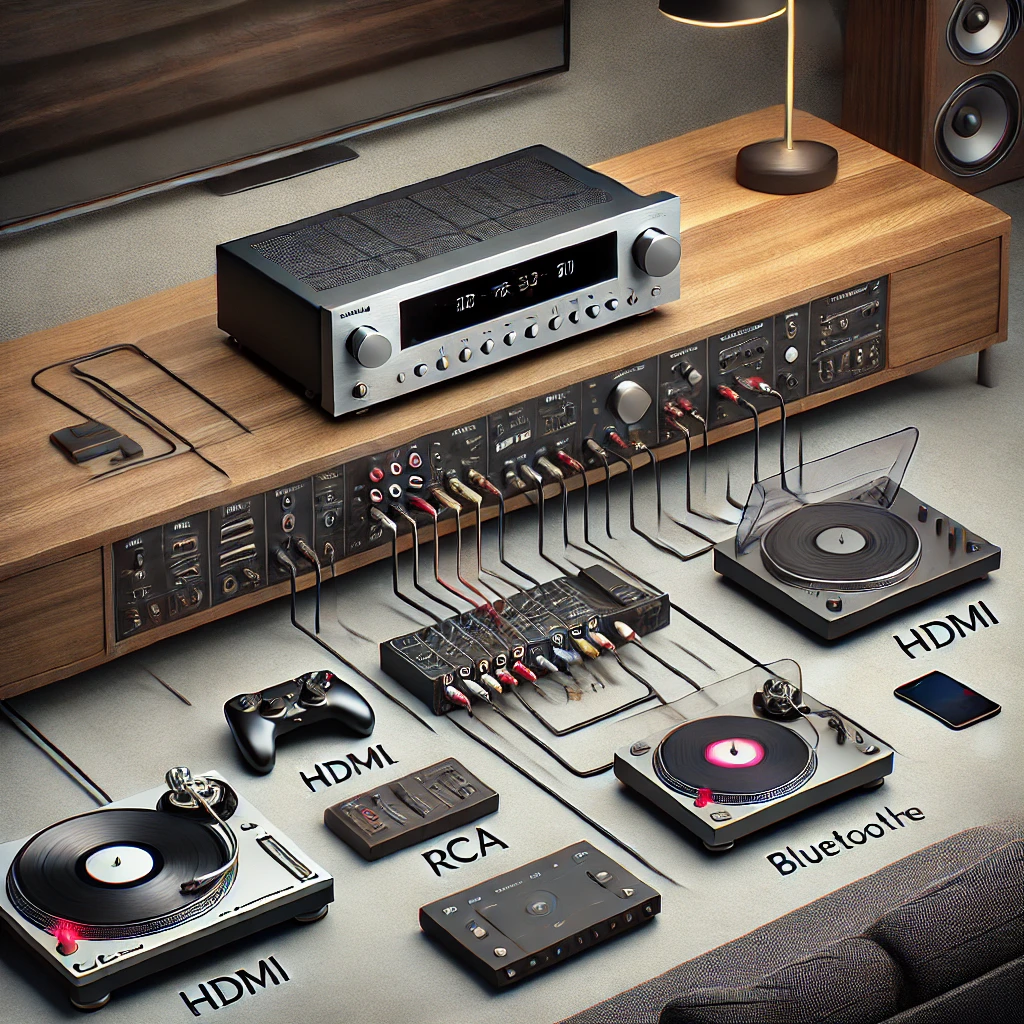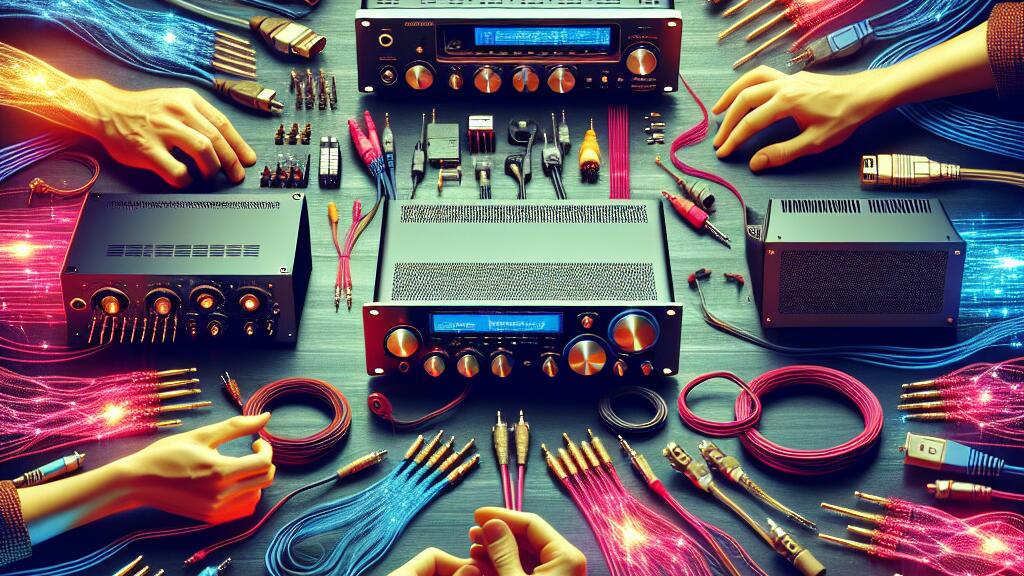Table Of Contents
Exploring Different Connection Options for Stereo Receivers to Enhance Your Audio Experience
Key Takeaways
- Summary of stereo receivers and their significance in audio systems
- Examination of various connection alternatives available for stereo receivers
- Description of commonly used connection methods and their functionalities
- Advantages associated with different connection techniques
- Guidance on selecting the appropriate connection based on individual requirements
Overview of Stereo Receivers
Stereo receivers play a pivotal role in creating a rich audio experience within stereo systems. These devices are essential for managing sound sources and providing high-quality stereo sound to speakers. Exploring different connection options for stereo receivers is crucial for optimizing audio performance. Whether you are connecting your home stereo to AV receivers or integrating with various stereo speakers, having a clear understanding of available wired and wireless solutions can enhance stereo imaging. A well-chosen receiver facilitates seamless connectivity, ensuring that every note is delivered with clarity and depth. With an array of features and compatibility options, selecting the right stereo receiver becomes integral to achieving an immersive listening experience.
- Importance of compatibility with speakers and sound sources
- Features to consider such as Bluetooth and Wi-Fi connectivity
- Power output and its effect on sound quality
- The significance of sound processing capabilities
- The role of multiple inputs and outputs for versatility
- Considerations for ease of use and remote control functionality
- Budget options available for different levels of audio enthusiasts
Defining Essential Stereo Receiver Features
A quality stereo receiver is at the heart of any audio system, maximizing the performance of high-fidelity audio setups. Essential features include multiple audio channels for rich sound reproduction and support for advanced formats like DTS-HD Master Audio. Exploring different connection options for stereo receivers enables seamless integration with various devices, such as a portable CD player or a pair of headphones. An integrated amplifier is often crucial for enhancing sound quality and ensuring compatibility with various audio signals.
Versatility stands out as a key attribute of modern stereo receivers, allowing users to enjoy multi-room audio experiences. The ability to connect via audio over Ethernet provides both convenience and superior sound quality. Many receivers today also include options for streaming, making it easier to access digital audio sources. Thoroughly understanding these essential features ensures you can build a robust and rewarding audio system tailored to your preferences.
Importance of Connection Options in Stereo Systems
Connection options play a critical role in the overall functionality of stereo systems. A well-designed setup can seamlessly integrate various audio components, including mp3 players, radio tuners, and streaming audio services. The ability to choose between analog audio and digital audio ensures compatibility with a diverse range of audio equipment. This flexibility allows users to enjoy background music through multiple sources, while also accommodating both old-school systems and modern technology with backward-compatible connections.
Choosing the right connections affects the quality and versatility of sound. Exploring Different Connection Options for Stereo Receivers can enhance the listening experience by facilitating multi-channel outputs and robust audio performance. Options like FM tuners, transmitters, and HDMI integration expand the possibilities of interaction with the stereo system. The perfect blend of wired and wireless solutions can transform how users engage with their favorite music streaming platforms, creating a rich auditory experience tailored to individual preferences.
Exploring Different Connection Options for Stereo Receivers
Exploring Different Connection Options for Stereo Receivers is crucial for optimizing sound quality and compatibility with various audio sources. Different stereo receivers support a range of connection types, allowing for integration with everything from tube amplifiers to modern digital theater systems. Wired connections, like RCA and optical cables, are essential for transmitting high-quality digital signals, especially for setups that include 5.1-channel surround sound. On the other hand, wireless solutions offer convenience by utilizing technologies like Bluetooth or Wi-Fi, making it easy to connect headphones or other devices without clutter. Understanding audio codecs, amplifiers, and features like the audio return channel enhances the usability of a stereo system, enabling users to create a rich audiovisual experience tailored to their preferences. Exploring Different Connection Options for Stereo Receivers ensures that users make informed choices that meet their unique audio needs.
Wired Connection Types for Stereo Receivers
Wired connections remain a cornerstone in the realm of audio systems, particularly for those building a reliable stereo setup. Many stereo receivers utilize RCA connections, which deliver consistent sound quality and are compatible with a wide range of audio devices. For a 2-channel stereo receiver, these connections allow for straightforward integration with other components, ensuring excellent performance across different stereo applications. Stereo receiver manufacturers often highlight the importance of wired connections in their models, as they provide a stable link to speakers and source devices.
Optical and coaxial connections also play a crucial role in wired setups, particularly in modern stereo receivers. These digital interfaces transmit high-quality audio signals, making them ideal for home stereo receivers that prioritize sound clarity. Collectors of rare stereo receivers often seek models with robust wired connection options to enhance their audio experience. Exploring Different Connection Options for Stereo Receivers reveals that wired solutions can lead to truly immersive listening experiences, particularly for those investing in the perfect stereo receiver for their 2-channel stereo system.
Wireless Connection Solutions for Modern Audio
Modern receivers have revolutionized the way we connect audio equipment, offering a range of wireless connection solutions that enhance the versatility of home stereo systems. Exploring different connection options for stereo receivers includes technologies like Bluetooth and Wi-Fi, which allow for seamless streaming from various devices. This flexibility is particularly beneficial for those looking to create a complete stereo setup, where components like a separate stereo amplifier and stereo speakers outdoors can be integrated without the clutter of cables.
Wireless solutions enable users to enjoy a wide stereo experience without compromising sound quality. With advancements in protocols such as MusicCast receivers, home stereo setups can easily control multiple zones throughout a space. This innovation transforms how audio is distributed, allowing for a more immersive listening experience in different environments, while maintaining the integrity of the original audio source in both 2-channel home stereo and larger systems. Exploring different connection options for stereo receivers ensures that users can find the best fit for their lifestyle and preferences.
- Stream music directly from smartphones and tablets via Bluetooth.
- Create multi-room audio setups with Wi-Fi-enabled speakers.
- Use voice control through smart assistants for hands-free operation.
- Connect various devices like laptops and smart TVs wirelessly.
- Enjoy high-resolution audio streaming with compatible receivers.
- Customize audio settings remotely through mobile apps.
- Easily expand your audio system with additional wireless speakers.
Popular Connection Options Explained
The landscape of home audio has evolved significantly, especially with the rise of new receivers designed to seamlessly integrate with various devices. Exploring different connection options for stereo receivers, including RCA connections, optical and coaxial inputs, and HDMI integration, is essential for achieving the perfect stereo system. Old stereo systems typically relied on basic wired connections, while current receivers offer flexible options that accommodate powered stereo speakers and several stereo amps. Using same-model receivers can simplify setup, ensuring compatibility across devices. With the right amplifier receiver or receiver/amplifier, users can maximize the potential of their home stereo gear and enhance their audio experience.
RCA Connections for Stereo Receivers
RCA connections remain a staple in the world of audio connections. Many receivers, including older models, utilize the red-and-white stereo RCA cables to deliver sound from various sources. Old receivers typically offer these connections for playback devices, while many modern all-in-one stereo systems integrate them with advanced features. For users looking to connect portable music devices or integrate with multi-zone receivers, understanding the nuances of RCA connections is crucial. Exploring different connection options for stereo receivers reveals why this traditional method continues to be popular despite the emergence of newer technologies.
The versatility of RCA connections is evident in their compatibility with a wide range of audio equipment. Sony receivers and other receiver brands often incorporate these ports, allowing for seamless integration with multi-room music platforms. While some may argue that RCA connections could lead to a poor stereo experience compared to digital alternatives, they still provide an easy and effective audio connection for many setups. Exploring different connection options for stereo receivers leads to a better understanding of how RCA cables fit into the larger audio landscape and the continued relevance they hold today.
Optical and Coaxial Connections
Optical and coaxial connections are vital for high-end receivers, offering clear digital audio transmission directly to your amp/receiver. These connections are commonly used in multi-room music systems, ensuring that compatible speakers receive high-quality sound. The clarity provided by these audio formats makes them a popular choice among audiophiles. For those setting up their first home stereo or enhancing an existing home theater receiver, these options prove to be effective for achieving superior audio performance.
For a more sophisticated setup, exploring different connection options for stereo receivers can lead to the integration of musiccast-capable devices. These connections support various audio decoding modes, making them suitable for both traditional and modern applications. With advancements in wireless multi-room music setups, many users find themselves balancing the ease of wireless with the reliability of optical and coaxial connections. Whether utilizing a Panasonic stereo music receiver or compatible wireless speakers, these connections remain essential for maintaining sound integrity across a multi-room music setup.
| Connection Type | Usage | Advantages |
|---|---|---|
| Optical Connection | Home Theater Systems | High-quality audio, reduced interference |
| Coaxial Connection | Multi-room Audio Systems | Compatible with various audio formats, durable design |
| HDMI (with Audio Return) | Modern AV Receivers | Transmits both audio and video, supports high-definition audio formats |
| 3.5mm Audio Jack | Portable Devices | Universal compatibility, easy to connect |
HDMI Integration for Audio Video Systems
HDMI integration has revolutionized the way audio and video equipment interact. The ability to transmit high-quality audio signals alongside video makes this connection method indispensable for modern systems. For those exploring different connection options for stereo receivers, a source receiver equipped with HDMI capabilities allows for seamless integration of various media devices. The r-n303 receiver, among others, supports multiple surround sound formats, enhancing the overall experience, especially when utilizing seven-channel receivers for surround sound setups or multi-room music solutions.
Investing in an advanced audio system that includes HDMI capability can significantly elevate your entertainment experience. With the right receiver, users can easily configure their systems to support rear surround speakers, ensuring immersive sound quality. Homeowners looking to establish a multi-room audio system can benefit from the versatility of HDMI connections, simplifying the process of connecting different devices without cluttering the space with numerous cables. Exploring different connections becomes less daunting with a solid understanding of how HDMI can streamline your audio and video needs.
Benefits of Various Connection Methods
Understanding the advantages of various connection methods is key for anyone exploring different connection options for stereo receivers. A great receiver often features multiple analog audio inputs and digital connections, ensuring compatibility with varied audio setups. An old Yamaha receiver might benefit from a matching amplifier to enhance sound quality, while a new receiver affords users the convenience of wireless multi-room audio and Bluetooth capabilities. Entry-level receivers may prioritize essential connections, but they can still cater to diverse music choices. Ultimately, the right connection approach guarantees seamless integration with compatible devices, greatly enhancing overall listening experiences.

Advantages of Wired Connections
Wired connections provide a reliable and consistent audio experience that many audiophiles prefer. Exploring Different Connection Options for Stereo Receivers reveals that these methods often deliver superior sound quality, especially for formats like digital surround sound. With wired connections, users can effectively control music playback without the latency typically associated with wireless surround sound systems. Devices such as multi-channel amplifiers and NAD surround receivers ensure that every detail of the audio format is reproduced accurately, making them a suitable choice for those who prioritize audio fidelity.
Another significant advantage is the ease of calibration and setup. Using an audio distribution amplifier allows users to calibrate speakers precisely, optimizing the sound stage for different music genres. Wired connections also eliminate potential interference that can occur with wireless connections, offering a stable alternative for connecting musicCast wireless speakers and other components. For anyone serious about their audio experience, wired connections represent a dependable and high-quality choice.
Perks of Opting for Wireless Connections
Wireless connections offer unparalleled flexibility and convenience, especially when exploring different connection options for stereo receivers. A wifi receiver allows seamless integration with musical streaming services, enabling users to connect a variety of speakers, from shelf speakers to surround speakers, without the clutter of cables. This modern approach eliminates the need for a conventional amplifier or separate amplifier, while still providing high-quality sound across various analog surround and digital sound formats.
Using wireless technology can simplify setup and enhance the listening experience. Consumers can easily connect to multiple devices, accessing music libraries and streaming platforms effortlessly. A high-quality 50-watt receiver paired with different speakers can deliver impressive audio performance without the limitations of traditional analog connections. The ability to switch between connection types on the fly further emphasizes the benefits of wireless setups, making it a popular choice among audio enthusiasts.
Choosing the Right Connection for Your Needs
Assessing compatibility with your stereo receiver requires a thorough understanding of the various elements involved. Exploring different connection options for stereo receivers can help ensure that your setup accommodates surround sound speakers and their respective surround speaker channels. It’s essential to consider the specific amplifier and its specifications, particularly regarding how it manages amplified signals. Some audiovisual components may only support certain video connections or require corresponding analog audio formats for optimal performance. The Cambridge Audio SR20, for instance, is known for its bass extension and airplay connectivity, which can enhance your listening experience in different settings. Taking the time to evaluate these features will lead to a more satisfying audio journey.

Assessing Compatibility with Your Stereo Receiver
Compatibility plays a crucial role in optimizing your audio experience. Exploring different connection options for stereo receivers involves understanding the specifications of your sound equipment. A 100-watt receiver paired with available speakers can deliver deep bass sounds and exceptional audio quality. Whether you opt for sound bars or traditional home audio equipment, ensuring a harmonious pairing with your seven-channel receiver lets you enjoy theater-like surround sound.
Proper assessment of sound signals is essential. A seven-channel receiver can handle various connections, so knowing whether your speakers have a negative connector or are compatible with modern amplifiers is key. This compatibility ensures high-quality playback and maximizes the potential of your system, allowing for rich soundscapes that elevate your listening experience. Exploring different connection options for stereo receivers is vital for achieving the best audio results.
Conclusion
Exploring Different Connection Options for Stereo Receivers is essential for any audiophile aiming for high-quality audio experiences. Understanding the connection aspect allows users to adapt their systems to various settings, whether in a home theater or a simple music setup. The advent of technologies like MusicCast facilitates seamless wireless integration without sacrificing sound fidelity. For those seeking true surround sound, wired connections often provide the most reliable audio quality, whereas wireless solutions offer flexibility and convenience. Ultimately, the right choice among these options depends on personal preferences and the demands of each unique audio environment.
FAQS
What should I consider when choosing different audio connection options for a stereo receiver?
When selecting a suitable amplifier or stereo equipment, it’s important to consider the amplifier specifications and whether a stereo/2-channel receiver meets your needs. Additionally, look into digital modulation options for audio and ensure the receiver has appropriate digital audio input. Bluetooth receivers and wireless surround transmitters can provide added flexibility in your home theater setup, especially if you are considering seven-channel A/V receivers to achieve a wide stereo experience in the stereo industry.
How can I choose between different audio connection options for my stereo receiver to ensure compatibility with various stereos?
When selecting audio connection options for a stereo receiver, it’s important to consider the stereo receiver buying process and the types of connections available in the wide stereo industry. Ensure that your receiver is a capable receiver by checking its compatibility with both common and obscure amplifier types. Using stereo male connectors, you can connect various devices, providing flexibility in how you set up your home theater receivers for optimal audio experience.
What are the advantages of using different audio connection options for enhancing stereo performance with various stereos?
Using different audio connection options can significantly enhance your stereo performance. Different audio connections, such as HDMI, optical, and RCA, provide distinct benefits depending on the type of stereos you are using. For instance, HDMI can support high-definition audio formats, while optical connections are excellent for reducing interference. Understanding the capabilities of your stereos and the advantages of these different audio connections will help you achieve optimal sound quality.
What factors should be evaluated to determine the best audio connection options available for a stereo receiver?
When evaluating the best audio connection options available for a stereo receiver, consider factors such as compatibility with your existing devices, audio quality, ease of use, and flexibility for future upgrades. Additionally, understanding the advantages of each type of connection will help you make an informed decision that enhances your overall audio experience.
What are some common audio connection options available for different stereo receivers?
Common audio connection options for different stereo receivers include HDMI, optical, coaxial, RCA, and Bluetooth. Each option has its own benefits, such as HDMI supporting multi-channel audio, optical reducing interference, and Bluetooth offering wireless connectivity, allowing you to enhance your audio experience based on your stereo setup.

